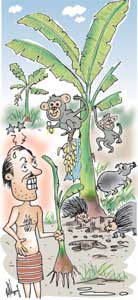
Going bananas!The fall-out from Land Reform thirty five years later
A victim of the Kobbekaduwa “Land Reforms” of the early seventies might be forgiven for the thought that the intervening thirty-odd years would have seen some alleviation of the massive damage done by that ill-advised effort to assuage the discontent of the youth who had rebelled against an SLFP government’s abandonment of its promises of the 1970 election, combined with a deliberately malicious attempt to “get” those seen as opponents of the Kobbekaduwa brand of “socialism”. Alas! The secondary growth of trees that have managed to compete successfully with the grass are now peopled by hordes of monkeys, families of giant (“rock”) squirrels and their nocturnal cousins, flying squirrels, who effectively destroy what the pigs and porcupines can’t reach! Talk about organized, integrated destruction!
Attempts to grow plantains/bananas will provide any interested researcher into potential factors of extreme frustration with interesting material. When the “sucker” is planted, along come the pigs to check whether the new plant or the hole in which it is planted contains any edible grubs. Rest assured that even if such life is not found, Mr Boar or Mrs Sow can do a pretty credible job of overturning the plantain sucker with or without the help of their progeny. This is not all. If there is a relatively dry spell after planting, the porcine pack will be back to knock over and chew on the succulent banana stems which they seem to find a particularly delectable fare. If one is so fortunate as to be able to save the plantain sucker and it reaches the stage of producing a bunch of plantains, the fun begins anew because, in very short order our macaque monkey friends decide to check out the prospects for a banana split or the monkey equivalent thereof. One protective measure available to the potential banana planter is encasing the bunch in a plastic bag. Have you ever tried to climb a plantain tree to do this? Anyway, the less said about that exercise the better! And assuming you have succeeded in encasing the bunch in a poultry-feed or fertiliser sack, one could find that said sack is not of high enough quality to withstand the depredations of our monkey friends who with their teeth and/or nails can reduce it to something that an enterprising dancer could easily fashion into the twenty-first century replacement for a Hawaiian grass skirt. If one is able to display exceptional agricultural entrepreneurship and is able to bring the plantain patch to the harvest stage, another challenge is before one: getting the product to market. The local mudalalis are not particularly enthusiastic about hiring transport to get to a few bunches of plantains because the approach road has been reduced to a state that could provide a reasonable challenge to an intrepid rock-climber. How so, you ask? Thanks to the local Pradeshiya Sabha that, in its wisdom and not, coincidentally, for lack of vehement protest against such action, has decided to locate a regional landfill (garbage dump for the uninitiated in such “respectable” terminology) half way up the hill on top of which said plantains have been grown and have now been harvested. This is barely the end of that story because, regional land fills are supposed to have lots and lots of garbage dumped in them. So, several times a day, along comes an (agricultural) tractor with trailer in tow, the latter loaded to the gunwales with a great variety of the detritus of civilization such as it is in the region. The driver can’t make up his mind whether he is the Sri Lankan equivalent of an Alonso, Schumacher or Hamilton, but, nevertheless pilots his vehicle at a speed that would do any of the afore-mentioned proud, with the unfortunate and inevitable result that the surface of the road has been reduced to significantly less than pristine condition. Thanks to this state of affairs, the plantain producer is compelled to deliver his produce to market, arranging the bunches of plantains inside and on top of a mode of conveyance which, I am sure, the manufacturers never imagined would be put to such use! After which the haggling begins as to appropriate price, how much “tare” should be reduced from each bunch for the stems (which are inedible) etc. This is but one little piece of the puzzle confronting someone seeking to re-establish an existence in the land of their birth. |
|| Front
Page | News | Editorial | Columns | Sports | Plus | Financial
Times | International | Mirror | TV
Times | Funday
Times || |
| |
Reproduction of articles permitted when used without any alterations to contents and the source. |
© Copyright
2008 | Wijeya
Newspapers Ltd.Colombo. Sri Lanka. All Rights Reserved. |
